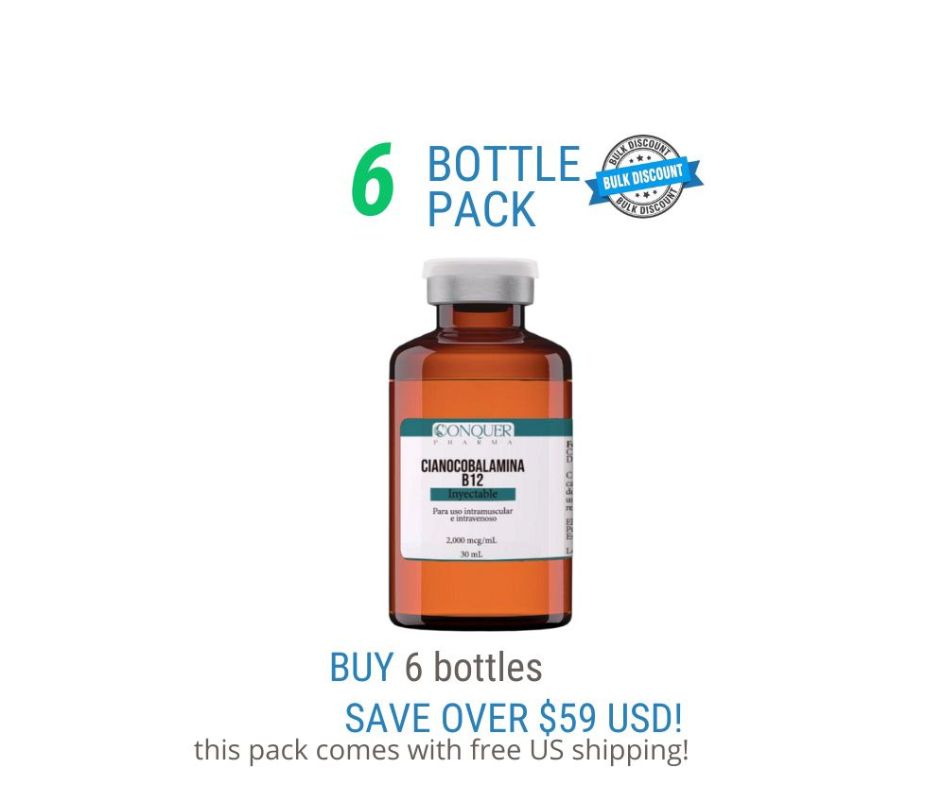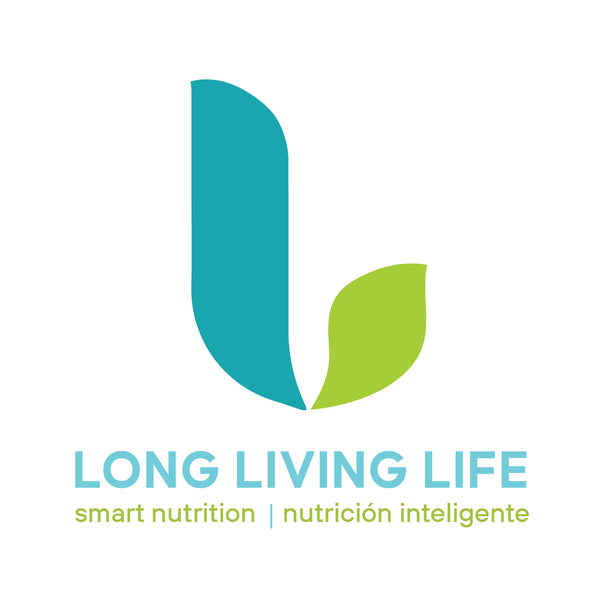My Store
6 Pack Offer-Cyanocobalamin (B12) Injection 2,000 mcg/mL 30mL Conquer Pharma
6 Pack Offer-Cyanocobalamin (B12) Injection 2,000 mcg/mL 30mL Conquer Pharma
Couldn't load pickup availability
Cyanocobalamin (b12) injection 2,000 mcg / mL Multiple dose for intravenous, intramuscular or subcutaneous use
GENERAL INFORMATION
Cyanocobalamin, or vitamin B12, is a B vitamin. It is found in a variety of foods such as fish, seafood, meats, and dairy products. Although vitamin B12 and the terms used interchangeably, vitamin B12 is also available as hydroxocobalamin, a less prescribed medication (see hydroxocobalamin monograph). Cyanocobalamin is available nasal, oral, and parenteral routes, and is equal in biological activity to hydroxocobalamin. Cyanocobalamin is used to treat pernicious anemia and vitamin B12 deficiency, as well as to determine vitamin B12 absorption in the Schilling test. Vitamin B12 is an essential vitamin found in foods like meat, eggs, and dairy products.Deficiency in healthy individuals is rare; the elderly, strict vegetarians (i.e. vegans) and patients with malabsorption problems have more problems becoming deficient. If vitamin B12 deficiency is not treated with a vitamin B12 supplement, it can cause anemia, intestinal problems, and irreversible nerve damage. Oral therapy is not always effective, as some people lack intrinsic factor, an endogenous substance produced by the stomach and necessary for the oral absorption of B12. Other patients may not be able to absorb oral vitamin B12 due to surgical removal or dysfunction of the intestines in the area where vitamin B12 absorption occurs.Therefore, parenteral or nasal therapy may be necessary; however, intranasal therapy should only be instituted for maintenance treatment after control of the condition has been obtained parenterally. Vitamin B12 is used to treat pernicious anemia and vitamin B12 deficiency, as well as to determine vitamin B12 absorption in the Schilling test. Cyanocobalamin was approved by the FDA in 1949. The intranasal measured gel solution (Nascobal®) form was approved in November 1996 for vitamin B12 deficiency resulting from various conditions; In 2002, such conditions were expanded to include use in patients with vitamin B12 deficiency with HIV infection, AIDS, or Crohn’s disease.A B12 intranasal aerosol solution, also called Nascobal®, with the same indications, was approved by the FDA in January 2005. Another intranasal aerosol, CaloMist ™, was approved in July 2007 for maintenance therapy after normalization with vitamin B12 IM. or Crohn’s disease. A B12 intranasal aerosol solution, also called Nascobal®, with the same indications, was approved by the FDA in January 2005. Another intranasal aerosol, CaloMist ™, was approved in July 2007 for maintenance therapy after normalization with vitamin B12 IM. or Crohn’s disease.A B12 intranasal aerosol solution, also called Nascobal®, with the same indications, was approved by the FDA in January 2005. Another intranasal aerosol, CaloMist ™, was approved in July 2007 for maintenance therapy after normalization with vitamin B12 IM.
Vitamin B12, or cyanocolbalamin, is essential to growth, cell reproduction, hematopoiesis, and nucleoprotein and myelin synthesis. Cells characterized by rapid division (epithelial cells, bone marrow, myeloid cells) appear to have the greatest requirement for cyanocobalamin. Vitamin B12 can be converted to coenzyme B12 in tissues; in this form it is essential for conversion of methylmalonate to succinate and synthesis of methionine from homocysteine (a reaction which also requires folate). In the absence of coenzyme B12, tetrahydrofolate cannot be regenerated from its inactive storage form, 5-methyl tetrahydrofolate, resulting in functional folate deficiency. Vitamin B12 also may be involved in maintaining sulfhydryl (SH) groups in the reduced form required by many SH-activated enzyme systems. Through these reactions, vitamin B12 is associated with fat and carbohydrate metabolism and protein synthesis. Vitamin B12 deficiency results in megaloblastic anemia, GI lesions, and neurologic damage (which begins with an inability to produce myelin and is followed by gradual degeneration of the axon and nerve head). Vitamin B12 requires an intrinsic factor-mediated active transport for absorption, therefore, lack of or inhibition of intrinsic factor results in pernicious anemia.
Pharmacokinetics:
Cyanocobalamin is administered intranasally, orally, and parenterally, while hydroxocobalamin is administered only parenterally. Once absorbed, vitamin B12 is highly bound to transcobalamin II, a specific B-globulin carrier protein and is distributed and stored primarily in the liver as coenzyme B12. The bone marrow also stores a significant amount of the absorbed vitamin B12. This vitamin crosses the placenta and is distributed into breast milk. Enterohepatic recirculation conserves systemic stores. The half-life is about 6 days (400 days in the liver). Elimination is primarily through the bile; however, excess cyanocobalamin is excreted unchanged in the urine.
Route-Specific Pharmacokinetics:
Intravenous Route: Peak plasma levels of cyanocobalamin are attained within 1 hour for parenteral doses.
Intramuscular Route: Bioavailability of the nasal gel and spray forms relative to an IM injection are about 9% and 6%, respectively. Because the intranasal forms have lower absorption than the IM dosage form, intranasal B12 forms are administered once weekly. After 1 month of treatment in pernicious anemia patients, the once weekly dosing of 500 mcg B12 intranasal gel resulted in a statistically significant increase in B12 levels when compared to a once monthly 100 mcg IM dose.
Contraindications/Precautions:
Who should not take this medication? Patients with early hereditary optic nerve atrophy, cyanocobalmin hypersensitivity, and those who are pregnant. Your health care provider needs to know if you have any of these conditions: kidney disease; Leber’s disease; megaloblastic anemia; an unusual or allergic reaction to cyanocobalamin, cobalt, other medicines, foods, dyes, or preservatives; pregnant or trying to get pregnant; breast-feeding.
Cyanocobalamin is contraindicated in patients with cyanocobalamin hypersensitivity or hypersensitivity to any of the medication components. Cyanocobalamin is also contraindicated in patients with cobalt hypersensitivity because cyanocobalamin contains cobalt. In the case of suspected cobalt hypersensitivity, an intradermal test dose should be administered because anaphylactic shock and death have followed parenteral administration of cyanocobalamin.
Intranasal formulations of cyanocobalamin are not suitable for vitamin B12 absorption test (Schilling Test).
Cyanocobalamin should not be used in patients with early hereditary optic nerve atrophy (Leber’s disease). Optic nerve atrophy can worsen in patients whose cyanocobalamin levels are already elevated. Hydroxocobalamin is the preferred agent in this patient population (see separate monograph in Less Common Drugs).
Most formulations of cyanocobalamin injection contain benzyl alcohol as a preservative. Benzyl alcohol may cause allergic reactions. Cyanocobalamin injections should be used cautiously in those patients with benzyl alcohol hypersensitivity. Cyanocobalamin, vitamin B12 preparations containing benzyl alcohol should be avoided in premature neonates because benzyl alcohol has been associated with ‘gasping syndrome,’ a potentially fatal condition characterized by metabolic acidosis and CNS, respiratory, circulatory, and renal dysfunction.
Vitamin B12 deficiency can suppress the symptoms of polycythemia vera. Treatment with cyanocobalamin or hydroxocobalamin may unmask this condition.
Folic Acid, vitamin B9 is not a substitute for cyanocobalamin, vitamin B12 deficiency, although it may improve vitamin B12 megaloblastic anemia. However, exclusive use of folic acid in treating vitamin B12 deficient megaloblastic anemia could result in progressive and irreversible neurologic damage. Before receiving folic acid or cyanocobalamin, patients should be assessed for deficiency and appropriate therapy started concurrently. The intranasal formulations are not approved to treat acute B12 deficiency; all hematologic parameters should be normal before beginning the cyanocobalamin intranasal formulations. Concurrent iron-deficiency anemia and folic acid deficiency may result in a blunted or impeded response to cyanocobalamin therapy.1
Certain conditions may blunt or impede therapeutic response to cyanocobalamin therapy. These include serious infection, uremia or renal failure, drugs with bone marrow suppression properties (e.g., chloramphenicol), or concurrent undiagnosed folic acid or iron deficiency anemia. The mechanism appears to be interference with erythropoiesis. Patients with vitamin B12 deficiency and concurrent renal or hepatic disease may require increased doses or more frequent administration of cyanocobalamin.
Patients with rhinorrhea (rhinitis) who are receiving the intranasal formulations of cyanocobalamin may experience decreased medication absorption secondary to nasal discharge. These patients may experience a blunted or impeded response to the intranasal medication. Treatment with intranasal cyanocobalamin should be delayed until symptoms resolve in patients with nasal congestion, allergic rhinitis, and upper respiratory infection. Intranasal cyanocobalamin therapy is not ideal for patients with chronic nasal symptoms or significant nasal pathology. If used in these patients, more frequent monitoring is required because of the potential for erratic or blunted absorption.
Parenteral and intranasal cyanocobalamin, vitamin B12 are classified as pregnancy category C. Adequate studies in humans have not been conducted; however, no maternal or fetal complications have been associated with doses that are recommended during pregnancy, and appropriate treatment should not be withheld from pregnant women with vitamin B12 responsive anemias. Conversely, pernicious anemia resulting from vitamin B12 deficiency may cause infertility or poor pregnancy outcomes. Vitamin B12 deficiency has occurred in breast-fed infants of vegetarian mothers whose diets contain no animal products (e.g., eggs, dairy), even though the mothers had no symptoms of deficiency at the time. Maternal requirements for vitamin B12 increase during pregnancy. The usual daily recommended amounts of cyanocobalamin, vitamin B12 either through dietary intake or supplementation should be taken during pregnancy (see Dosage).
Cyanocobalamin is distributed into breast milk in amounts similar to those in maternal plasma, and distribution in breast milk allows for adequate intakes of cyanocobalamin by breast-feeding infants. Adequate maternal intake is important for both the mother and infant during nursing, and maternal requirements for vitamin B12 increase during lactation. According to the manufacturer, the usual daily recommended amounts of cyanocobalamin, vitamin B12 for lactating women should be taken maternally during breast-feeding (see Dosage). The American Academy of Pediatrics considers vitamin B12 to be compatible with breast-feeding. Consider the benefits of breast-feeding, the risk of potential infant drug exposure, and the risk of an untreated or inadequately treated condition. If a breast-feeding infant experiences an adverse effect related to a maternally ingested drug, healthcare providers are encouraged to report the adverse effect to the FDA.
Studies of intranasal cyanocobalamin did not include sufficient numbers of geriatric patients aged >= 65 years to determine whether the clinical response differs from that of younger patients. Other clinical reports have not identified differences in responses between elderly and younger patients. Generally, dose selection for elderly patients should be done with caution. Elderly patients tend to have a greater frequency of decreased hepatic, renal, or cardiac function, and also have concomitant disease or receiving other drug therapy. Start with doses at the lower end of the dosing range.
This list may not include all contraindications.
Share


